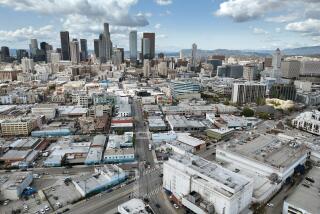Rotterdam Embarks on a New, 10-Year Rebuilding Plan With Some Bizarre Results
ROTTERDAM, Netherlands — World War II bombing tore the heart out of Rotterdam, and decades of social engineering failed to put it back. Now the city has embarked on a new rebuilding plan with some startling designs.
It is urgently trying to undo the damage done to its image, its night life and its income by the German bombing and the now-discarded planning ideas of the immediate postwar period.
After the war, old city center housing which had been reduced to rubble by the May, 1940, bombing was replaced by featureless office blocks of steel and concrete as the city built itself into one of Europe’s foremost trade centers. It is the world’s busiest port.
New housing was built mainly around the outskirts, stripping the center of inhabitants and character.
Bizarre Results
As the rebuilding went ahead, planners and architects indulged their fantasies with an enthusiasm that has produced some bizarre results--and caustic comments.
The original 1945 plan was to segregate the living and the working areas of the city. But by the late 1960s this policy had provoked so much public outcry and created such a vacuum in the center that a radical rethinking was forced.
The new 10-year plan until the mid-1990s is to rebuild character and people back into the center, according to Jan Willem Vader, chief planning engineer of the city’s central district.
“The whole inner-city plan, which includes a new shopping complex, an arts area and a leisure area, is to make Rotterdam more attractive to work in, live in and visit,” Vader said.
‘Like a Fantastic Dream’
As part of this new grand design, and latest in a long line of oddities, is the provisional approval of a new apartment complex designed by prominent architect Piet Blom.
The new design has tall thin towers and onion-shaped domes, prompting one city politician to liken it to the Kremlin. Ruud van Middelkoop added, “It seems to me like a fantastic dream, and I hope it stays that way.”
This is a not unusual reaction to Blom’s work. As Vader said, “One of the guaranteed facets of Blom’s designs is that they are unusual and they provoke strong reactions.”
Blom is also responsible for a number of existing developments.
Shaped Like Treehouses
In one complex, the apartments are shaped like boxes standing on one corner on concrete supports that look like tree trunks. Each yellow “tree house” holds one self-contained flat, all joined by walkways and reached by stairs.
When the apartments first came onto the market in 1984 there was a rush to buy, followed almost immediately by a rush to sell.
One enterprising tenant opened his apartment for paying sightseers and in the first three months had 25,000 visitors.
Nearby is another of Blom’s housing complexes, nicknamed Monkey Mountain because of its shape. In the same area, another Blom apartment building is shaped like a pencil and has been dubbed the Garden Gnome.
New Image Sought
Blom’s brief is partly to create a new image for the city, including elements of historical city design, but also to reflect in part the highly cosmopolitan nature of the population, which includes 104 different nationalities.
The new plans include a new building in the center that would be Rotterdam’s tallest and most futuristic office tower. The city is also planning a huge shopping mall with hotel, shops, movie theaters, a casino and nightclubs on open ground near the city’s central station.
The developments have the joint aim of giving Rotterdam a new and progressive face, while at the same time trying to attract higher-income earners back into the center.
One of Rotterdam’s problems is that having pushed most of the 570,000 inhabitants out of the center, it has also evacuated the very people who would have helped give the city its character.
Income, Employment Problems
This policy has also meant that most of the inhabitants work in and around the center but spend their money in the suburbs.
The difficulties have been exacerbated both by the income and employment problems facing the port and by the distinct eccentricity of some of the building designs.
Vader said it was hoped to have much of the new building and attempted revitalizing of the city completed by May, 1990, for a major celebration of 50 years since the bombing devastation.
“Rotterdam used to have a thriving center and night life before the war, and has led the way in a number of planning and architectural developments since then.
“The plan is not only to attract people back, but also to create more employment that is not directly tied to the port,” Vader said.
More to Read
The biggest entertainment stories
Get our big stories about Hollywood, film, television, music, arts, culture and more right in your inbox as soon as they publish.
You may occasionally receive promotional content from the Los Angeles Times.










